In my travels, I often hear folks that are new to prepping express surprise. Surprise at how much work it is! I know most folks have the idea that you can get a case of MREs, a few jugs of water, and a survival radio and call yourself ready, but being truly prepared is a little more… complicated.
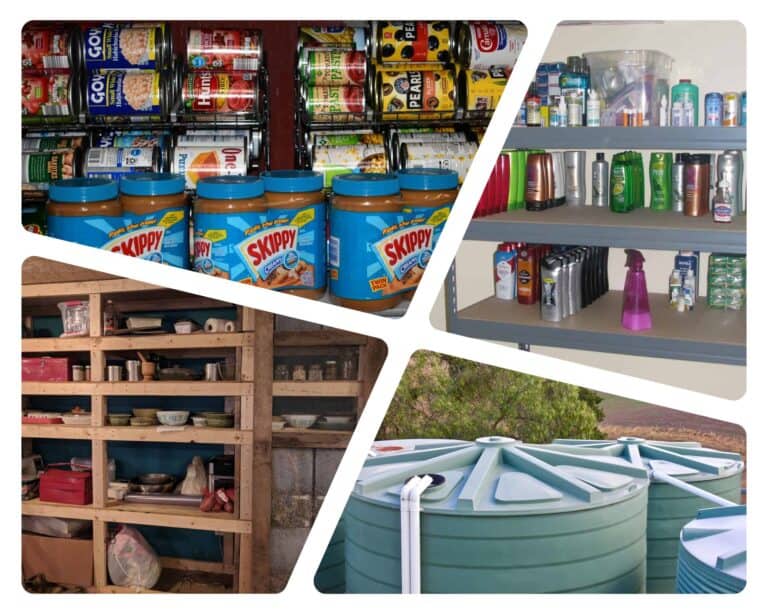
A big component of the difficulty is actually the logistics of it: human beings have needs, what we call survival necessities, for sustained existence over time.
Consumables are naturally some of the most important, with food and water being high on the list. Without enough water or calories every day, you are doomed.
Amassing a large enough stash of food, water, and other gear can be a huge undertaking, something that takes a lot of money and time. But if you’re unprepared or started too late and trouble is just on the horizon, you’ll have to act fast.
Luckily, with the right approach, it’s possible to build a one-month survival stockpile in just 24 hours. Keep reading and I’ll tell you how.
Just the Basics
If you’ve spent any amount of time reading about prepping, you probably have noticed that there’s always something else to prepare for.
Some threat you overlooked, some scenario you’ve never thought of. In a way, it’s easy to get sucked into a spiral of doomsday prophecy: you can never call it good enough, never let yourself rest on what you’ve already prepared for!
That’s a philosophical conversation we will put aside for now, but it can help to focus us for our current mission. We are not trying to get ready for every niche event that might possibly occur. We are just trying to take care of the basics, and do so as quickly as we can.
You don’t have to get ready for a nuclear war or a zombie apocalypse; for now, just get prepared for a long wait without clean water, a stable food supply, or reliable sources for fuel.
Those things are always, and I do mean always, valuable no matter what situation you’re facing. You can take care of the other stuff later.
Move Fast
One thing to keep in mind: if you woke up today and the sun is shining, but you have a weight pressing down on you that you need to get ready for tough times ahead, rejoice:
Follow the plan I’m about to share with you and within one day you’ll be better prepared than 95% of the population.
However, if you are reading this because there is an actual, tangible disaster about to occur, maybe a huge hurricane, riot, or something else, you’ve got to move fast and be smart:
There will be thousands, maybe tens of thousands, of other people just like you out there scrambling to get what they need before someone else gets to it.
In this latter scenario, it is going to be ugly and your success is anything but certain. Do your best, and consider that this exact scenario is why preppers constantly preach that folks get ready before trouble arrives.
Where to Shop
Keep things simple. You can get all of the following items at grocery stores, big box club stores, hardware stores, and similar retailers that are in your town right now or very nearby.
Spend a day, maybe two, shopping and you can get everything that you and your family will need to survive for a month in just about 24 hours’ worth of actual work.
I’ll tell you more about the exact survival requirements in the relevant sections below…
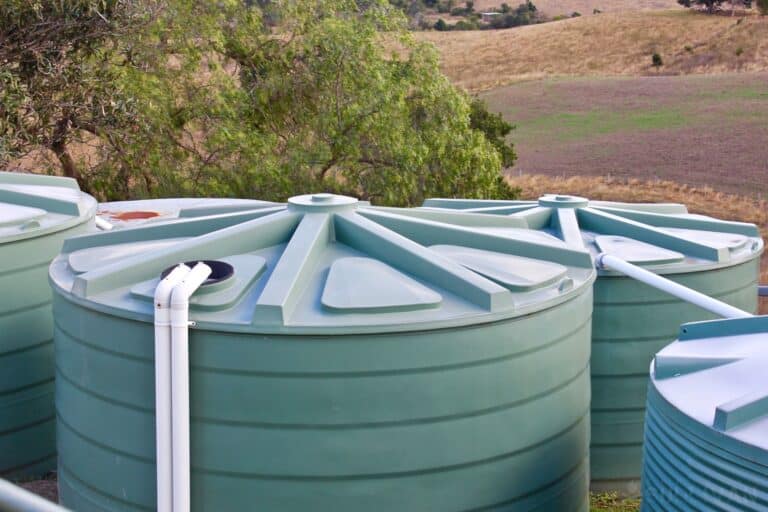
five large rainwater tanks
Water
- Requirement: 1 gallon per person per day; covers drinking, cooking, and basic hygiene.
- What to Get: water storage drums or other containers.
- Where to Get It: hardware store or farm supply store.
Water is, of course, one of the most critical survival necessities. Any person can only go a few days without any water, and rest assured you will be totally incapacitated well before death comes for you.
What even seasoned preppers sometimes underestimate is that you’ll need more water when you are working hard and perspiring in a hot environment, and you’ll also need some for basic hygiene and food prep.
Accordingly, a good guideline is that you should have one gallon of water per person in your family, and that’s per day. That means a 30-day supply of water for a family of four is approximately 120 gallons.
That is a colossal amount of bottled water, and though you should definitely have a few cases on hand, it’s not practical to get and store that much in just 24 hours. A better solution is to get large water storage drums or other containers that you can fill up.
Your local hardware store or farm supply store should have portable water storage drums that will hold about 50 gallons. Get three of those and you are covered for the month with a little extra to spare, either as a hedge or water enough to take care of the family pet.
Don’t forget the necessary hardware to seal up the drums if needed and pump water out of it.
Another item you should look out for, one that you can get at outdoor stores and some department stores, is a bathtub basin. Basically, this is a large water storage bag that you set in a bathtub and fill up from the tap, capable of holding dozens of gallons on demand.
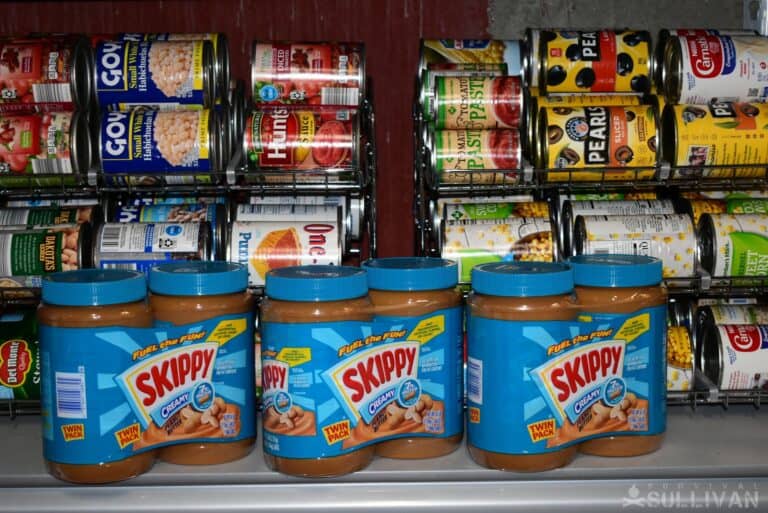
cans of peanut butter on pantry shelves
Food
- Requirement: approx. 2,000 calories per person, per day.
- What to Get: shelf-stable, easy-to-prepare or ready-to-eat foods that are high in calories.
- Where to Get It: grocery store, big box club store.
Food is also a survival necessity, but compared to water, folks somewhat under-prioritize it because you can go for weeks on end without any food before you starve.
But just like water, your mental and physical condition will be severely degraded long before you starve to death. Accordingly, regular intake of calories will keep your body strong and your mind sharp, two major assets in any survival scenario.
As a rough guideline, plan on a person needing about 2,000 calories a day (60,000 per person, per month), but this assumes only a modest level of activity.
If you are working hard day in and day out or are stressed, you will need more calories. The thing with stockpiling is that it takes up a lot of room, especially if it is canned.
Raw, bulk calories will keep you alive but it takes a toll on your psyche, and a lack of needed vitamins and minerals will degrade your health over time.
A varied diet is always a good thing, even in a survival situation. Plus, we are on a tight deadline here, so we need to make do with what is readily available.
Head to your local grocery store or big box club store like Costco or Sam’s Club. The first thing you should get is several great big jars of peanut butter.
Just two tablespoons of peanut butter will have anywhere from 190 to 230 calories, with lots of fat and protein and plenty of minerals to boot.
Love it, like it, or hate it, it is an awesome, shelf-stable, and ready-to-eat survival food. Look at the serving size info on the back of the package, calculate the total calories in the container, and then divide that by the calorie needs of your family per day to see how far a single container will get you.
But you don’t want to get just peanut butter. Like I said, a varied diet is a good idea…
You should get easy-to-prepare staples like rice, dried beans, oats, pasta, instant potatoes, and various canned meats, fruits, and veggies to round things out, along with shelf-stable snacks like Pop-Tarts that the family enjoys. Keeping morale up is important too!
If you’ve been paying attention, you will have noticed that several of those items like the instant potatoes, pasta, rice, and beans will require boiling water to prepare. That’s part of the reason we are stockpiling so much!
However, that water won’t help if you can’t boil it, and under the circumstances, it’s smart to have a propane or charcoal grill, fire pit, or some other off-grid method of boiling water ready to go with enough fuel for the duration of the crisis.
With a little luck, you won’t need it and you can just bunker down at home and use your kitchen as normal, but don’t count on it.
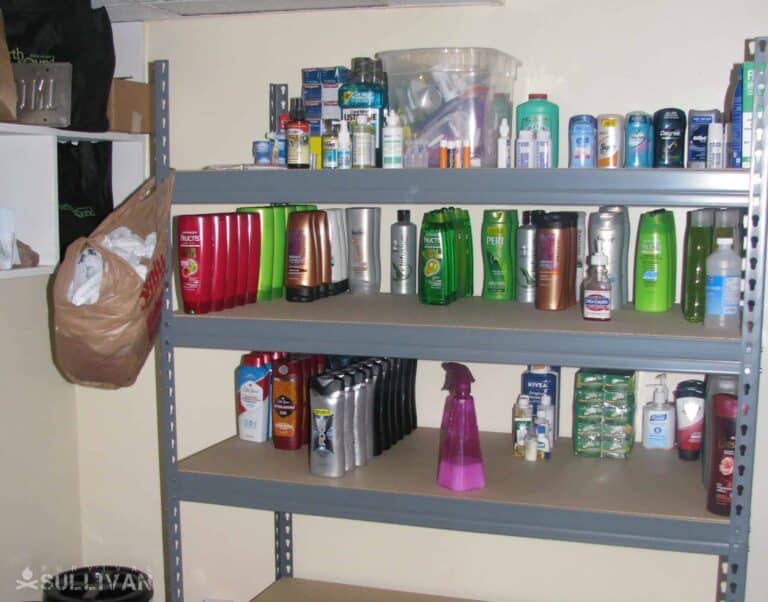
hygiene items on pantry shelves: shampoo, shower gel, mouthwash, toothpaste, moisturizing cream, lip balm, deodorant sticks
Sanitation
- Requirement: a safe way to store and dispose of human waste for the duration of the crisis.
- What to Get: 5-gallon buckets with lids, camping toilet seat, heavy-duty trash bags, bleach, kitty litter, baby wipes.
- Where to Get It: hardware store, camping and outdoor store, department store.
This is a crucial facet of survival that few beginners remember and almost nobody wants to talk about. That’s because it’s really gross. Nonetheless, we’ve got to do it.
Sanitation is a huge concern in every kind of survival scenario: Your average adult will produce over a pound of feces a day and 40 to 50 fluid ounces of urine.
Happily, we don’t have to deal with any of it when our toilets and sewer systems are working normally. Unhappily, you can’t count on either during a long-term survival scenario.
If you don’t have a safe way to store and dispose of that waste, you and your family will be living in hell in no time, and the stage will be set for pestilence.
Outbreaks of disease associated with human waste are especially devastating and will be made worse by a lack of readily available medical care.
As a bulwark against this outcome, we can use primitive but effective means in the form of 5-gallon buckets, with lids, and heavy-duty contractor bags.
Using the bags as a liner and the bucket as an improvised toilet, you can do your business more or less as you always have and then safely contain the waste for later disposal.
If you can’t find a Snap-On camp toilet seat for the bucket to make things more comfortable and familiar, you can improvise a toilet seat from two planks of smooth, scrap wood.
Other items to get for the purpose include kitty litter to absorb moisture and odor in the toilet, bleach for keeping things sanitized and killing germs, and baby wipes for keeping yourself clean.
Hopefully, you won’t need any of this stuff, especially if you have a septic system, but hope is not a strategy for survival.
Medical
- Requirement: supplies and meds for treating basic injuries and ailments; any prescribed meds needed by you or family.
- What to Get: bandages, gauze, antiseptic, first-aid tape, OTC meds, prescription meds
- Where to Get It: drugstore, department store, pharmacy.
Injury and illness go hand in hand with disasters of all kinds. You might escape serious injury but still have to contend with cuts, bruises, and sickness. You need to be prepared for these eventualities.
When making one of your stops, stock up on rolled gauze and gauze pads, antiseptic spray or liquid, first-aid tape, adhesive bandages, and a battery of over-the-counter medications for treating pain, fever, diarrhea, nausea, and other conditions.
Something that might be tricky to get under the circumstances but vital all the same is any prescription medicine that you or a family member needs for ongoing treatment. This could be anything from antibiotics to heart medication.
If you have time and opportunity, put in a call to your family doctor and have them fast-track the prescription over to the pharmacist. Be sure to explain why you want it…
If your doctor is unreachable or you’re in a serious hurry, head to the pharmacy and plead your case to the pharmacist. You’ve got better chances of getting an emergency supply if you’ve picked up from that pharmacy before.
Keep in mind that some medications have their own storage requirements, maybe refrigeration as is the case with insulin or something else.
Tools and Support
- Requirement: basic equipment to help you deal with damage and loss of services.
- What to Get: see below
- Where to Get It: hardware store, department store, camping/outdoor store.
A big part of prepping is having the right kind of gear and tools on hand to help you cope with damage and decisively deal with emergent problems. I can, and have, written at length about this subject, producing huge lists of must-have gear that every prepper should own.
You could spend 24 hours gathering just those tools, and we don’t have that kind of time considering we need a lot of other things. The following represents, to me, the most crucial items to have for facing a wide variety of situations.
The good news is these are available almost anywhere and for not much money. You should be able to snag these at one of the stops you are already making for the supplies above.
Flashlights
In almost all situations the power will go out. Whether it’s after sunset or in the bowels of a large building, you’ll need flashlights to see.
Get a good, sturdy variety that has multiple output settings so you can conserve power based on your needs. Make sure you get tons of extra batteries.
Headlamps
A headlamp offers you a redundant backup to a flashlight, but more importantly, hands-free lighting. Compared to a flashlight, it doesn’t need to be as bright or have as long a range, but you should strive to get one with multiple output modes and, ideally, one that has battery commonality with your flashlights.
Emergency Radio
Emergency radios, sometimes called weather radios, are typically crank-powered small radio sets that can tune into government and NOAA alert bands.
Even if the internet goes down, even if the power is out, even if your smartphone is lost, dead, or broken, you can get updates on what’s happening in your area using one of these.
Dust Masks
Major disasters like tornadoes, hurricanes, industrial accidents, rioting, earthquakes, and more will invariably put lots of debris and dust into the air. You don’t want to breathe this stuff. Get a large multi-pack of high-efficiency dust masks or, if you want to spring for them, half-face respirators with filters.
Gloves
Chances are you’ll be dealing with wreckage and dangerous stuff for the duration of the crisis. Protect your hands.
Get at least one set of gloves for each adult in your family, and preferably a set for everyone. Heavy-duty cotton or leather work gloves are ideal. Consider the lightweight mechanics-style gloves if you want something with better dexterity.
Emergency Blankets
These are the lightweight, gold or silver foil blankets you see people wrapped up in at the scene of an accident or in the aftermath of a disaster when first responders arrive.
That’s because they work: emergency blankets can reflect up to 90% of your lost body heat back at your body, keeping you dramatically warmer. Inexpensive and highly compact, keep about a dozen of these on hand.
Ponchos
Basic, pullover-style rain ponchos might be rudimentary, but they can work wonders for keeping you and yours dry if you’re forced to be outside or evacuate in bad weather.
Even if you plan on staying put, you might have cause to go outside during a downpour. If you’ve already got good rain gear for everyone in the family, you can skip these.
Tarps
Every seasoned prepper knows that tarps are a true ace-in-the-hole survival item. You can use tarps to quickly craft an emergency shelter, cover a hole in a leaky roof, as a ground cover, rain catcher, and a whole lot more. I suggest you get the completely waterproof plastic or rubberized style versus canvas.
Duct Tape
Another unsung but supremely useful item to have in your survival toolbox. Duct tape is perfect for quick and crafty improvisations or repairs, sealing up windows against smoke or gas, and countless other uses.
Get at least three big rolls of high-quality tape and put them away only for emergency use – don’t raid the rolls when you need it for a project at home!
Gas Cans
Last but certainly not least, it’s a good idea to keep fuel on hand. At a minimum, I would have at least 10 extra gallons of fuel for your daily driver vehicle.
This can be tricky because you both need to store it safely to reduce the massive fire hazard it represents, and also because the fuel needs to be rotated regularly; it doesn’t last forever and will go bad!
Keep in mind you might not be the only person that desperately needs this; it could be a family member, friend, or neighbor.
30-Day Ready!
And with all of that, you’ve got everything you and your family need to survive for a whole month. Make no mistake, you’ll be roughing it, and it will definitely feel like it, but the supplies and gear you have gathered will make all the difference in your outcomes.
Another thing to consider: these supplies will form an excellent core for your future preparations…
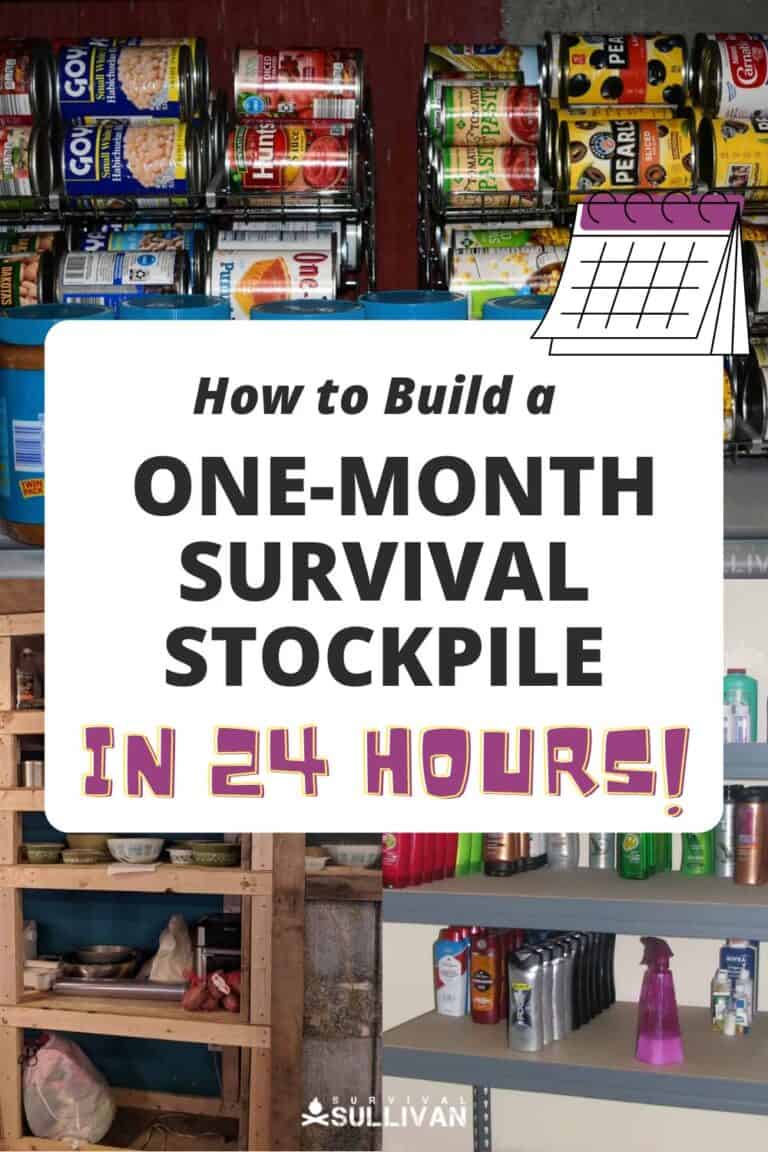
The post How to Build a One-Month Survival Stockpile in 24 Hours! appeared first on Survival Sullivan.
By: Tom Marlowe
Title: How to Build a One-Month Survival Stockpile in 24 Hours!
Sourced From: www.survivalsullivan.com/build-one-month-stockpile-in-a-day/
Published Date: Sat, 12 Oct 2024 12:05:04 +0000
------------------------
 What is BushcraftSurvival SkillsToolsVideosBushcraft CampsBushcraft KitsBushcraft ProjectsPrivacy PolicyTerms And Conditions
What is BushcraftSurvival SkillsToolsVideosBushcraft CampsBushcraft KitsBushcraft ProjectsPrivacy PolicyTerms And Conditions
